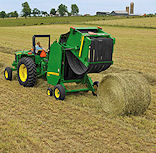
The sun was bright and the temperature nearly perfect for people as different companies whacked down tall, fourth cutting alfalfa, then raked previously cut alfalfa, and also baled hay in large bales at the Purdue University/Indiana Forage Council Forage Day late last week. The event was held on the Eric Miles farm in the southeast corner of Wayne County. He and his family farm about 400 acres, but have the distinction of farming in three counties since their land lies in the corner of three counties.
Who does Miles sell hay to? "Anybody who has the money," he quipped, when asked the question during the field day. Most often today, he sells to dairymen. That's because he converted his hay operation to big square bales a few years ago. There are some large dairies in the area that can utilize big bales. He also sells some to cattle feeders for beef cattle hay.
Hay and cattle are the biggest enterprises on the farm. Right now they concentrate on hay, and have an 80-cow beef herd, utilizing pasture on rougher ground. Someday they would like to expand the beef herd to about 120 cows, Miles notes.
"The two enterprises go together pretty well," he says. "If we have hay that isn't top quality for selling, we utilize it through our own animals."
Staying financially sound is the biggest challenge in agriculture today, Miles believes. He made that comment when asked about challenges on the farm. He started farming with no prior experience in 1994. Miles chose hay and cattle because it didn't appear he could not rent other land in the area very easily, so hay and cattle looked like the best ways to make a living off the farm they had.
The crowd that visited Forage Day this year was somewhat smaller than usual. This is the first time, at least in a long time, it has been held in September rather than June. The beautiful weather for haymaking was a plus for Forage Day participants, but was also tempting to those who still had their own fourth cutting to finish to stay home and either cut or bale.
However, entries in the hay contest seemed to be up. Dozens of bales were lined up for testing by mid-morning. Hay is checked for nutritional value through lab analysis, then prizes are awarded in various categories.
About the Author(s)
You May Also Like




